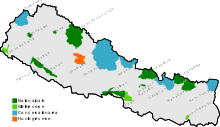Protected areas of Nepal
The protected areas of Nepal cover mainly forested land and are located at various altitudes in the Terai, in the foothills of the Himalayas and in the mountains, thus encompassing a multitude of landscapes and preserving a vast biodiversity in the Palearctic and Indomalayan realms. Nepal covers 147,181 km2 (56,827 sq mi) in the central part of the Himalayas. Altitudes range from 67 m (220 ft) in the south-eastern Terai to 8,848 m (29,029 ft) at Sagarmatha within a short horizontal span. This extreme altitudinal gradient has resulted in 11 bio-climatic zones ranging from lower tropical below 500 m (1,600 ft) to nival above 5,000 m (16,000 ft) in the High Himalayas, encompassing nine terrestrial ecoregions with 36 vegetation types. Botanists recorded 1,120 species of non-flowering plants and 5,160 species of flowering plants. Nepal ranks 10th in terms of richest flowering plant diversity in Asia. Zoologists recorded 181 mammal species, 844 bird species, 100 reptile species, 43 amphibian species, 185 freshwater fish species, and 635 butterfly species. In recognition of the magnitude of biodiversity the Government of Nepal has established a network of 20 protected areas since 1973, consisting of ten national parks, three wildlife reserves, six conservation areas and one hunting reserve.[1][2][3][4][5] In 2017, the Shuklaphanta and Parsa Wildlife Reserves were upgraded to National Parks.

Additionally, nine Ramsar sites were declared between 1988 and 2008.[6]
National parks
- Chitwan National Park – 952.63 km2 (367.81 sq mi)
- Sagarmatha National Park – 1,148 km2 (443 sq mi)
- Langtang National Park – 1,710 km2 (660 sq mi)
- Rara National Park – 106 km2 (41 sq mi)
- Khaptad National Park – 225 km2 (87 sq mi)
- Shey Phoksundo National Park – 3,555 km2 (1,373 sq mi)
- Bardiya National Park – 968 km2 (374 sq mi)
- Makalu Barun National Park – 1,500 km2 (580 sq mi)
- Shivapuri Nagarjun National Park – 159 km2 (61 sq mi)
- Banke National Park – 550 km2 (210 sq mi)
- Shuklaphanta National Park – 305 km2 (118 sq mi)
- Parsa National Park – 637 km2 (246 sq mi)
Wildlife reserves
- Koshi Tappu Wildlife Reserve – 175 km2 (68 sq mi)
Conservation areas
- Annapurna Conservation Area – 7,629 km2 (2,946 sq mi)
- Kanchenjunga Conservation Area – 2,035 km2 (786 sq mi)
- Manaslu Conservation Area – 1,663 km2 (642 sq mi)
- Blackbuck Conservation Area – 15.95 km2 (6.16 sq mi)
- Api Nampa Conservation Area – 1,903 km2 (735 sq mi)
- Gaurishankar Conservation Area – 2,179 km2 (841 sq mi)
Hunting Reserve
- Dhorpatan Hunting Reserve – 1,325 km2 (512 sq mi)
Ramsar Sites
The following Ramsar sites were declared between 1988 and 2008:[6]
- Bishazari Tal – 3,200 ha (12 sq mi)
- Ghodaghodi Tal – 2,563 ha (9.90 sq mi)
- Gokyo Lake Complex – 7,770 ha (30.0 sq mi)
- Gosaikunda – 13.8 ha (34 acres)
- Jagdishpur Reservoir – 225 ha (0.87 sq mi)
- Kosi Tappu Wildlife Reserve – 17,500 ha (68 sq mi)
- Mai Pokhari – 90 ha (220 acres)
- Phoksundo Lake – 494 ha (1.91 sq mi)
- Rara Lake – 1,583 ha (6.11 sq mi)
- Lake Cluster of Pokhara Valley – 261.1 km2 (100.8 sq mi)[7]
References
- Bhuju, U. R., Shakya, P. R., Basnet, T. B., Shrestha, S. (2007). Nepal Biodiversity Resource Book. Protected Areas, Ramsar Sites, and World Heritage Sites. International Centre for Integrated Mountain Development, Ministry of Environment, Science and Technology, in cooperation with United Nations Environment Programme, Regional Office for Asia and the Pacific. Kathmandu, ISBN 978-92-9115-033-5
- Bhushal, R. P. (2010). Nod to Banke National Park. The Himalayan Times, 13 May 2010
- Chaudhary, H., Poudyal, L.P. Bird Survey of Api Nampa Conservation Area in Nepal, 2016: Report to the Api Nampa Conservation Area Office, Khalanga, Darchula, Nepal. Kathmandu, Nepal: Nepalese Ornithological Union and Department of National Parks and Wildlife Conservation.CS1 maint: multiple names: authors list (link)
- NTNC (2010). Gaurishankar Conservation Area Project. National Trust for Nature Conservation, Nepal.
- DNPWC (2014). Blackbuck Conservation Area Archived 2015-01-28 at the Wayback Machine. Department of National Parks and Wildlife Conservation, Kathmandu.
- Bhandari, B. B. (2009). Wise use of Wetlands in Nepal. Banko Janakari 19 (3): 10–17.
- Baral, S.; Dhakal, M.; Khanal, R. (2016). Lake Cluster of Pokhara Valley. Kathmandu: Department of National Parks and Wildlife Conservation, IUCN Nepal.